1. Introduction
 After we finished testing the Pioneer DVR-110D drive, Pioneer released a new firmware version (v1.17) that promised a lot of changes including improved writing quality. In this review, we mainly test the drive's writing quality with several DVD media.
After we finished testing the Pioneer DVR-110D drive, Pioneer released a new firmware version (v1.17) that promised a lot of changes including improved writing quality. In this review, we mainly test the drive's writing quality with several DVD media.
New readers are advised before proceeding, to read the original Pioneer DVR-110D review that contains the full reading tests.
- What changed with fw 1.17?
According to Pioneer, some new media has been added to the supported media list while the writing quality with CD and DVD media has been improved. The already good reading performance had also improved according to Pioneer.
New 16x DVD-R Media: DAXON
New 16X DVD+R Media: DAXON
New 12X DVD+R Media: RITEK
DVD-ROM Readability improved
DVD-/+R Writability improved
DVD-R/+R DL Writability improved
DVD-RW/+RW Writability improved
CD-ROM Readability improved
CD-R/-RW Read and Writability improved
 Along with the release of the DVR-110D, Pioneer will release four other models, two SuperMulti format and two Dual format. These are the DVR-110DBK (Dual), the DVR-110DSV (Dual), the DVR-110 (SuperMulti) and the DVR-110BK (SuperMulti). The first two drives are to be released pretty much the same time as the reviewed drive, while the other two drives are to be released later on this year (late September).
Along with the release of the DVR-110D, Pioneer will release four other models, two SuperMulti format and two Dual format. These are the DVR-110DBK (Dual), the DVR-110DSV (Dual), the DVR-110 (SuperMulti) and the DVR-110BK (SuperMulti). The first two drives are to be released pretty much the same time as the reviewed drive, while the other two drives are to be released later on this year (late September).
Name |
Type |
Color |
DVR-110DBK |
Dual format (without DVD-RAM write) |
Black front bezel |
DVR-110DSV |
Dual format (without DVD-RAM write) |
Silver front bezel |
| DVR-110 |
SuperMulti format (with DVD-RAM write) |
Beige front bezel |
DVR-110BK |
SuperMulti format (with DVD-RAM write) |
Black front bezel |
- Features
The DVR-110D features the Precision Recording Technology, which utilizes an auto-adjustable writing technique to enable recording under the best conditions for each disc characteristic at all times. This technology, first introduced in the DVR-A06, enables the DVR-110D to achieve optimal initial writing performance and helps to minimize the normal deterioration of re-recordable discs due to repeated writing. As a result, the quality for repeatedly used DVD-RW discs is up to 10 times better than previous writers.
- Specifications
| DVD |
DVD-R, DVD-RW, DVD+R, DVD-R DL (Dual Layer), DVD+R DL (Double Layer) DVD+RW |
| CD |
CD-R 700(type 80), 650MB(type 74), CD-RW, Ultraspeed CD-RW, Highspeed CD-RW |
| Read Support |
| DVD |
DVD-ROM (single layer and DL), DVD-R, DVD-RW, DVD+R, DVD-R DL (Dual Layer), DVD+R DL (Double Layer), DVD+RW, DVD-RAM (Non-cartridge DVD-RAM Version 2.0/2.1 only) |
| CD |
CD-ROM(Mode 1), CD-ROM XA Mode 2 (form1, form 2), CD-DA, CD-Extra (CD Plus), Video CD, PhotoCD (single/multi-session), CD-Text, CD-R, CD-RW (High-speed CD-RW, Ultra Speed CD-RW) |
| Write Speed |
| DVD-R |
16x, 12x, 8x, 6x, 4x, 2x, 1x |
| DVD-RW |
6x, 4x, 2x, 1x |
| DVD-R DL |
8x, 6x, 4x, 2x |
| DVD+R |
16x, 12x, 8x, 6x, 4x. 2.4x |
| DVD+RW |
8x, 6x, 4x, 2.4x |
| DVD+R DL |
8x, 6x, 4x, 2.4x |
| 8cm DVD-R/RW, DVD+R/RW with Adapter |
2x, 1x |
| CD-R |
40x, 32x, 24x, 16x, 10x, 4x |
| CD-RW |
32x, 24x, 20x, 16x, 10x, 4x |
| Read Speed |
| DVD-ROM (single) |
Max 16x CAV |
| DVD-ROM (dual) |
Max 12x CAV |
| DVD-R, DVD+R |
Max 12x CAV |
| DVD-RW,DVD+RW |
Max 8x CAV |
| DVD+DL |
MAX 8x CAV |
| DVD-RAM |
Max 2x CLV |
| DVD-Video (Single Layer) |
5x CAV |
| DVD-Video (Dual Layer) |
5x CAV |
| CD-ROM, CD-R |
Max 40x CAV |
| CD-RW |
Max 32x CAV |
| Video CD |
9.3x CAV |
| Installation |
| Mounting Orientation |
Horizontal and Vertical |
| IDE Interface |
ATAPI PIO Mode 4, Multi word DMA Mode 2 16.6 Mbytes/sec. Ultra DMA mode 4 66.6 MBytes/sec. |
| Data Buffer (size) |
2 MBytes (Write, Read) |
| Dimensions (W x H x D) |
148mm x 42.3mm x 180mm |
- Specific application program(s) that support above format(s) required.
- Supported media required for specific DVD & CD writing speeds.
- To perform DVD writing at 12x or 16x speeds, use Pioneer-designated disc media.
As Pioneer suggests "...To achieve the specified writing and reading performance it is important that the DVR-110 is connected to the IDE port via an 80 way ribbon cable and that the IDE port is at least UDMA 66 or above...". Let's now see the drive's main characteristics as given by NeroInfoTool
and DVDInfoPro:
- The Drive
We received the beige coloured bezel model (the DVR-110D) bulk version with no accompanying bundled software. As Pioneer informs.. "If required a Software Installation CD containing Nero 6.6 OEM Suite 3 is available as an optional extra (NOT FREE) and needs to be requested at the time of purchasing the drive. Be sure to request the official Pioneer software CD (refer image opposite) otherwise you may receive a lesser alternative or no software at all.."
The front of the drive is quite simple, no Pioneer logo (much like the Pioneer DVR-109 model released some months ago).

On the rear you can find the analogue audio outpu, the IDE selection pins, the IDE connector and the power input. As Pioneer suggests, the use of an 80pin IDE ribbon cable is required to get the maximum possible throughput from the DVR-110D drive.

The label with manufacturing and compliance details, located on the drive, top view.

- Inner view
Now, let us take a look at the interior of the drive, a quick glance under the hood of this OEM release. Don't do this yourself as it will render the warranty void. You can just make out the main chipset, the same one that was used in the previous model, the DVR-109 burner. If not, then a click on the picture below to take you to a larger, more detailed view of the drive's mainboard and chipsets.


- Installation
The device was connected to our test PC and was identified as "PIONEER DVD-RW DVR-110D" under WinXP.

2. DVD Recording Tests
We burned 4315MB of data on various DVD±R, DVD±RW media. We used the maximum allowed writing speed for each disc.
- DVD-R/-RW media

The fastest time when burning at 16X with DVD-R media according to our tests, was 6:01min. It is rather good that many 8X certified media, allowed writing at up to 12X.
- DVD+R/+RW media

Once again, the 12X speed is something you'll see with many media, either 8X or 16X. But we would like more media to be supported at 16X. The maximum writing time for this format was 5:42min, which is a rather slow time.
3. Official supported Media List v1.17
When referring to the media list and when reference is made to a media ID code, this code is only accessible by using software designed to interrogate and display such information from a piece of blank media in the drive. It is possible that not all, particularly low cost media will contain a recognisable media ID. As for the brand information, some manufacturers make OEM for various media distribution companies so the actual printed name on the disc or packaging may not be that of the actual disc manufacturer.
- DVD-R 8X
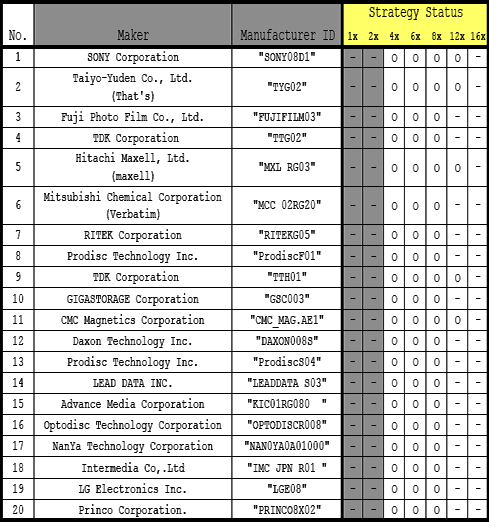 |
On discs other than the above, 4X writing is possible |
- DVD-R 16X
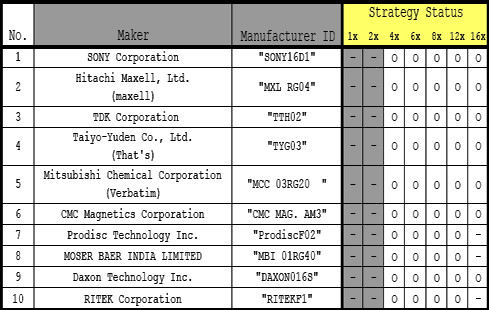 |
On discs other than the above, 4X writing is possible |
- DVD-R DL
 |
On discs other than the above, 2X writing is possible |
- DVD-RW
DVD-RW Ver1.0 (1x format disc)
On all discs, 1x writing is possible |
DVD-RW Ver1.1 (1x format disc)
On all discs, 1x writing is possible |
DVD-RW Ver1.1 Rev1.0 (2x format disc)
On all discs, 1x,2x writing is possible |
DVD-RW Ver1.2 Rev2.0 (4x format disc)
On all discs, 2x,4x writing is possible |
DVD-RW Ver1.2 Rev3.0 (6x format disc)
On all discs, 2x,4x,6x writing is possible |
- DVD+R 8X
 |
On discs other than the above, 4X writing is possible |
- DVD+R 16X
 |
On discs other than the above, 4X writing is possible |
- DVD+R 2.4X DL
 |
On discs other than the above, 2.4X writing is possible |
- DVD+R 8X DL
On all discs, 2.4x writing is possible.
- DVD+RW
 |
On discs other than the above, 3.3X writing is possible |
4. CDSpeed/PlexTools Scans - Page 1
In order to test the writing quality and readability of the burned media, we used two readers and two software applications:
- The LiteON SOHD-167T with patched firmware being able to read DVD5 up to 16X CAV and DVD9 up to 10X CAV. For the transfer rate tests we used the latest Nero CDSpeed version.
- The Plextor PX-716A with the latest available firmware. For scanning the disc, we used the latest PlexTools version at 2X CLV reading speed, BURST mode, with middle accuracy.
In general, a "perfect" disc should have a smooth reading curve, very low PIE/POE and zero (0) POF error rates. Most times however, even though a disc has very low PIE/POE error rates, the reading curve may not be smooth containing dropoffs. Due to the fact that we oversped the reading capabilities of the LiteON SOHD-167T, such drops are expected, especially near the outer area of the disc.
The measurements below should be taken not as the absolute criteria of the burning quality, but as an indication level.
16X DVD-R Writing Speed
- MKM 16X DVD-R @ 16X


- CMC Magnetics 16X DVD-R @ 16X
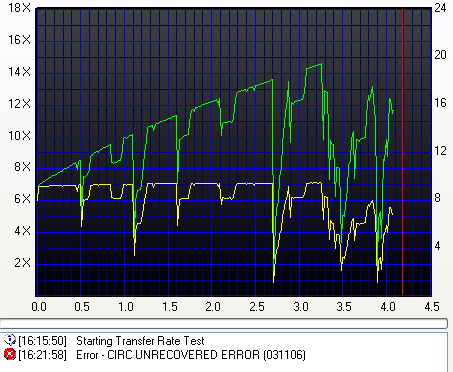

- BenQ 16X DVD-R @ 16X

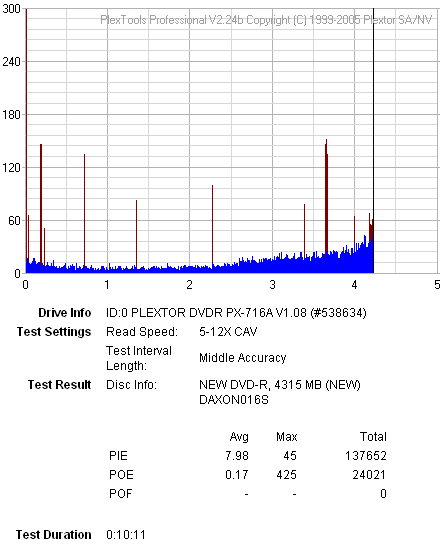
- Summary
Writing quality with DVD-R 16X media is actually very good, according to the Plextools graphs, where the PI levels are extremely low. CD-Speed though does not fully confirm the results reported by the Plextools utility, having some distorted graphs with many drops in speed, while in the case of CMC Magnetics media, it failed to finish the test just before the end.
5. CDSpeed/PlexTools Scans - Page 2
In order to test the writing quality and readability of the burned media, we used two readers and two software applications:
- The LiteON SOHD-167T with patched firmware being able to read DVD5 up to 16X CAV and DVD9 up to 10X CAV. For the transfer rate tests we used the latest Nero CDSpeed version.
- The Plextor PX-716A with the latest available firmware. For scanning the disc, we used the latest PlexTools version at 2X CLV reading speed, BURST mode, with middle accuracy.
In general, a "perfect" disc should have a smooth reading curve, very low PIE/POE and zero (0) POF error rates. Most times however, even though a disc has very low PIE/POE error rates, the reading curve may not be smooth containing dropoffs. Due to the fact that we oversped the reading capabilities of the LiteON SOHD-167T, such drops are expected, especially near the outer area of the disc.
The measurements below should be taken not as the absolute criteria of the burning quality, but as an indication level.
12X DVD-R Writing Speed
- Traxdata 16X DVD-R @ 12X
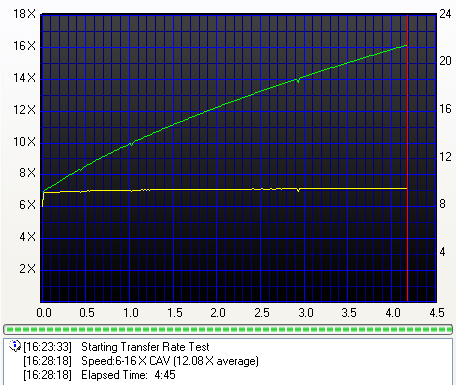
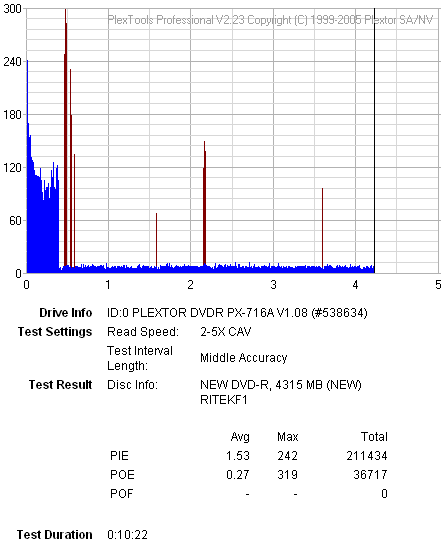
- CMC Magnetics 8X DVD-R @ 12X
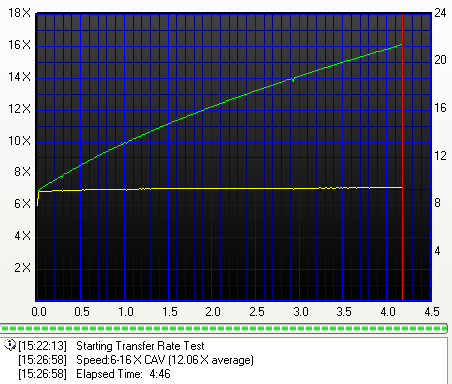

- Datawrite 8X DVD-R @ 12X


- Maxell 8X DVD-R @ 12X
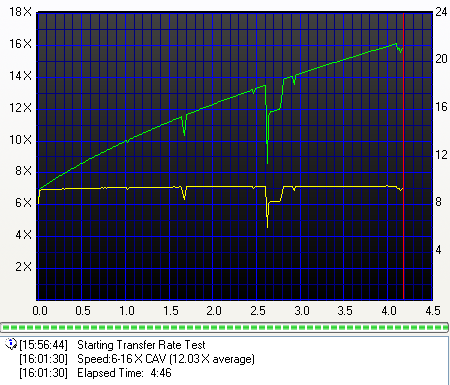

- TY 8X DVD-R @ 12X

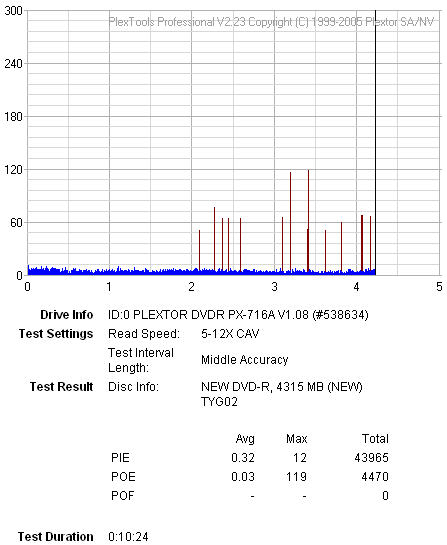
- TDK 8X DVD-R @ 12X

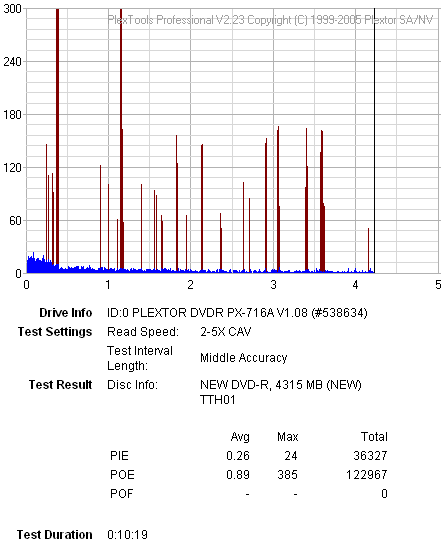
- Summary
The DVR-110D managed to burn many certified 8X media at 12X. The reported quality according to our measurements is excellent. The drive burned at 12X with high quality all the media we tried. Low error rates with Plextools and smooth reading graphs from CDSpeed.
6. CDSpeed/PlexTools Scans - Page 3
In order to test the writing quality and readability of the burned media, we used two readers and two software applications:
- The LiteON SOHD-167T with patched firmware being able to read DVD5 up to 16X CAV and DVD9 up to 10X CAV. For the transfer rate tests we used the latest Nero CDSpeed version.
- The Plextor PX-716A with the latest available firmware. For scanning the disc, we used the latest PlexTools version at 2X CLV reading speed, BURST mode, with middle accuracy.
In general, a "perfect" disc should have a smooth reading curve, very low PIE/POE and zero (0) POF error rates. Most times however, even though a disc has very low PIE/POE error rates, the reading curve may not be smooth containing dropoffs. Due to the fact that we oversped the reading capabilities of the LiteON SOHD-167T, such drops are expected, especially near the outer area of the disc.
The measurements below should be taken not as the absolute criteria of the burning quality, but as an indication level.
8X DVD-R Writing Speed
- MKM 8X DVD-R @ 8X

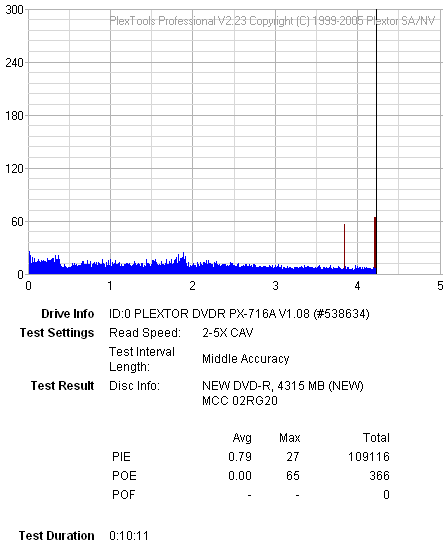
- MMore 8X DVD-R @ 8X
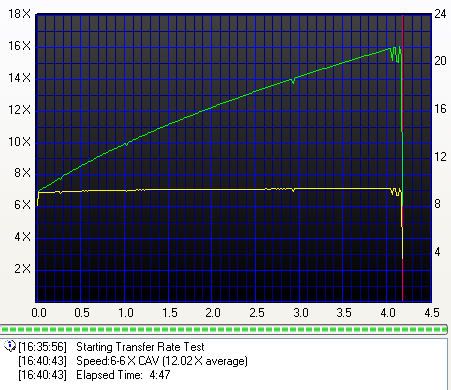

- Bulkpaq 8X DVD-R @ 8X

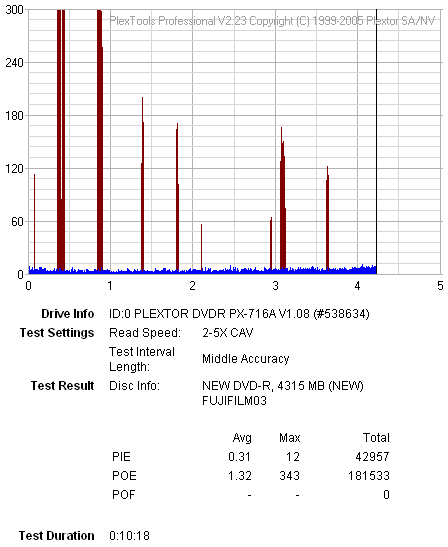
- Ridisc(Blue) 8X DVD-R @ 8X

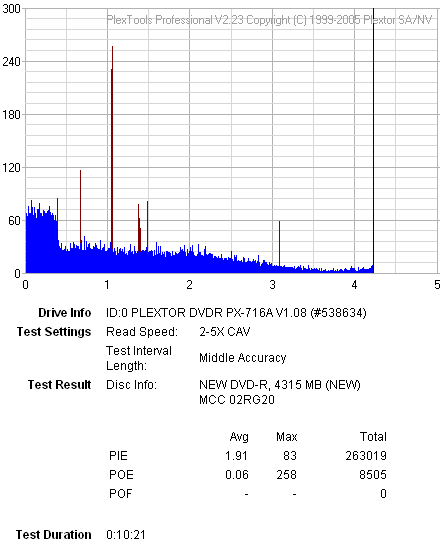
- Ridisc(Red) 8X DVD-R @ 8X
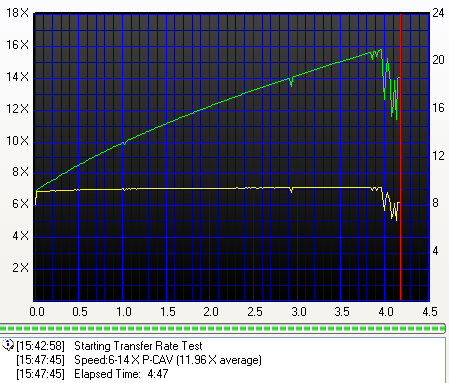

- Traxdata 8X DVD-R @ 8X


- Optodisc 8X DVD-R @ 4X
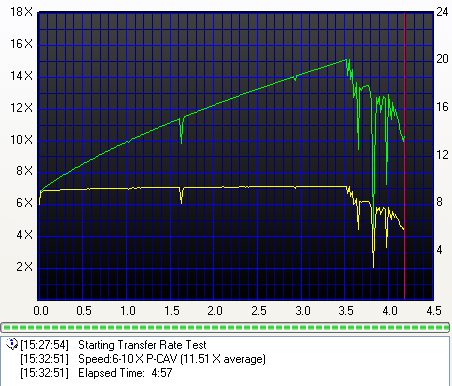

- Summary
Once again, low error levels were reported by Plextools for all burned media. The CDSpeed graphs are near perfect in the majority of cases. Very good writing at 8X with the DVR-110D.
7. CDSpeed/PlexTools Scans - Page 4
In order to test the writing quality and readability of the burned media, we used two readers and two software applications:
- The LiteON SOHD-167T with patched firmware being able to read DVD5 up to 16X CAV and DVD9 up to 10X CAV. For the transfer rate tests we used the latest Nero CDSpeed version.
- The Plextor PX-716A with the latest available firmware. For scanning the disc, we used the latest PlexTools version at 2X CLV reading speed, BURST mode, with middle accuracy.
In general, a "perfect" disc should have a smooth reading curve, very low PIE/POE and zero (0) POF error rates. Most times however, even though a disc has very low PIE/POE error rates, the reading curve may not be smooth containing dropoffs. Due to the fact that we oversped the reading capabilities of the LiteON SOHD-167T, such drops are expected, especially near the outer area of the disc.
The measurements below should be taken not as the absolute criteria of the burning quality, but as an indication level.
16X DVD+R Writing Speed
- MKM 16X DVD+R @ 16X


- TDK 16X DVD+R @ 16X


- BenQ 16X DVD+R @ 16X


- Summary
Fw1.17 improved the writing quality with DVD+R media at 16X where in the case of Mitsubishi Chemicals and Daxon, the outcome is outstanding.
8. CDSpeed/PlexTools Scans - Page 5
In order to test the writing quality and readability of the burned media, we used two readers and two software applications:
- The LiteON SOHD-167T with patched firmware being able to read DVD5 up to 16X CAV and DVD9 up to 10X CAV. For the transfer rate tests we used the latest Nero CDSpeed version.
- The Plextor PX-716A with the latest available firmware. For scanning the disc, we used the latest PlexTools version at 2X CLV reading speed, BURST mode, with middle accuracy.
In general, a "perfect" disc should have a smooth reading curve, very low PIE/POE and zero (0) POF error rates. Most times however, even though a disc has very low PIE/POE error rates, the reading curve may not be smooth containing dropoffs. Due to the fact that we oversped the reading capabilities of the LiteON SOHD-167T, such drops are expected, especially near the outer area of the disc.
The measurements below should be taken not as the absolute criteria of the burning quality, but as an indication level.
12X DVD+R Writing Speed
- Ricoh 16X DVD+R @ 12X


- MMore 16X DVD+R @ 12X


- Philips 16X DVD+R @ 12X


- Maxell 8X DVD+R @ 12X


- MKM 8X DVD+R @ 12X


- TDK 8X DVD+R @ 12X


- TY 8X DVD+R @ 12X


- Summary
Extremely low error rates from Plextools and very good and smooth CDSpeed reading graphs. Overall, very good writing quality with DVD+R media at 12X.
9. CDSpeed/PlexTools Scans - Page 6
In order to test the writing quality and readability of the burned media, we used two readers and two software applications:
- The LiteON SOHD-167T with patched firmware being able to read DVD5 up to 16X CAV and DVD9 up to 10X CAV. For the transfer rate tests we used the latest Nero CDSpeed version.
- The Plextor PX-716A with the latest available firmware. For scanning the disc, we used the latest PlexTools version at 2X CLV reading speed, BURST mode, with middle accuracy.
In general, a "perfect" disc should have a smooth reading curve, very low PIE/POE and zero (0) POF error rates. Most times however, even though a disc has very low PIE/POE error rates, the reading curve may not be smooth containing dropoffs. Due to the fact that we oversped the reading capabilities of the LiteON SOHD-167T, such drops are expected, especially near the outer area of the disc.
The measurements below should be taken not as the absolute criteria of the burning quality, but as an indication level.
8X DVD+R Writing Speed
- Traxdata 8X DVD+R @ 8X


- Ricoh 8X DVD+R @ 8X


- MMore 8X DVD+R @ 4X


- Samsung 8X DVD+R @ 4X


- Summary
Once again, amazing performance. The reading errors in CDSpeed with Samsung media do not detract from the very good performance of the DVR-110D burner.
10. CDSpeed/PlexTools Scans - Page 7
In order to test the writing quality and readability of the burned media, we used two readers and two software applications:
- The LiteON SOHD-167T with patched firmware being able to read DVD5 up to 16X CAV and DVD9 up to 10X CAV. For the transfer rate tests we used the latest Nero CDSpeed version.
- The Plextor PX-716A with the latest available firmware. For scanning the disc, we used the latest PlexTools version at 2X CLV reading speed, BURST mode, with middle accuracy.
In general, a "perfect" disc should have a smooth reading curve, very low PIE/POE and zero (0) POF error rates. Most times however, even though a disc has very low PIE/POE error rates, the reading curve may not be smooth containing dropoffs. Due to the fact that we oversped the reading capabilities of the LiteON SOHD-167T, such drops are expected, especially near the outer area of the disc.
The measurements below should be taken not as the absolute criteria of the burning quality, but as an indication level.
DVD±RW
- Traxdata 6X DVD-RW @ 6X
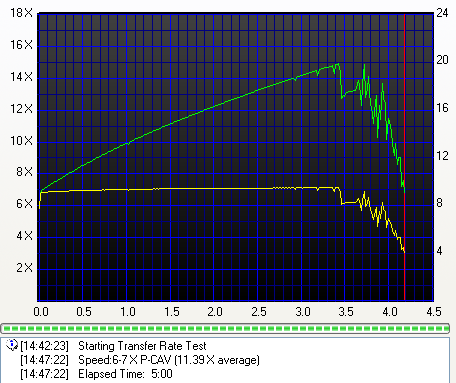
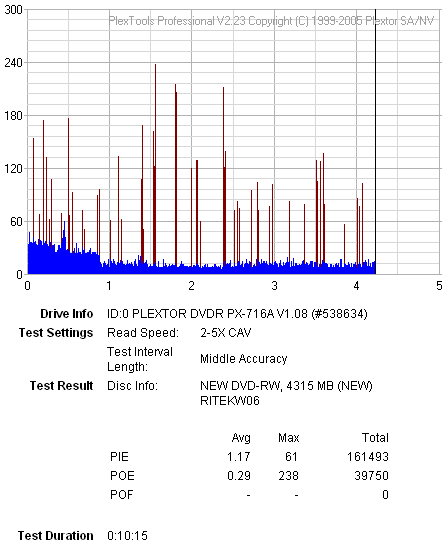
- Verbatim 6X DVD-RW @ 6X

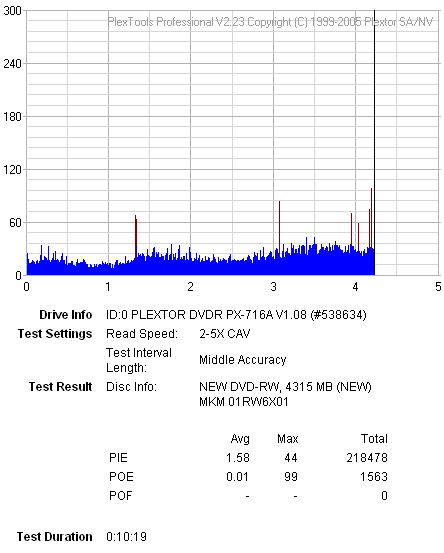
- Ricoh 8X DVD+RW @ 8X


- Summary
The writing quality with DVD-RW media is good. Both burns with Traxdata and Mitsubishi Chemicals media reported low PIE error levels while the CDSpeed reading graphs were also good, especially with Mitsubishi Chemicals media. With DVD+RW media, the only disc we managed to burn at 8X due to firmware limitations, was that from Ricoh which reported improved writing quality with fw1.17. Generally, things are slightly better with the newer firmware and re-writable media.
11. Writing Quality - Almedio AEC-1000
The AEC-1000 consists of a DVD Drive and the "ALChecker" error measurement application which can check the written data quality. The application is capable of 1X CLV measurement as well as 4X CLV on DVD-Video/ROM and finalized DVD+R/-R media.
There are three measurement modes:
- Fine Mode: checks a series of eight consecutive ECC blocks,
- Rough Mode: checks eight consecutive ECC blocks every 100h ECC blocks
- Quick Mode: checks three specified areas
The checking status is shown graphically in real time while you can save the error graph at the end of the test. The reported errors are the PI and the UncPO. In the case of PI, it counts the number of rows corrected by the PI error correction in each group of eight consecutive ECC blocks. In the case of UncPO, it counts the number of ECC blocks in which more than one byte is uncorrectable in eight consecutive ECC blocks. For our quality scans, we set for 1X CLV and Fine Mode which is the slowest and with the safest results. Also, we chose to measure all the media burned at the maximum available writing speed, namely 16X.
- CMC Magnetics 16X DVD-R @ 16X

- Verbatim 16X DVD-R @ 16X

- Traxdata 16X DVD-R @ 12X

- Verbatim 16X DVD+R @ 16X

- TDK 16X DVD+R @ 16X

- Ricoh 16X DVD+R @ 16X

Five out of six measured media managed to pass this quality test with good condition reported.
12. DVD+R DL - Page 1
DVR-110D offers 8X writing support for both DL formats.
For our tests this time, we chose the "Create Data Disc" feature of the CDSpeed utility. The reason for this is that we wanted to fully burn the DL media instead of just the 6.86GB we usually used.
Now let's take a look at the writing strategy for both +R and -R DL.
- DVD+R DL

- DVD-R DL
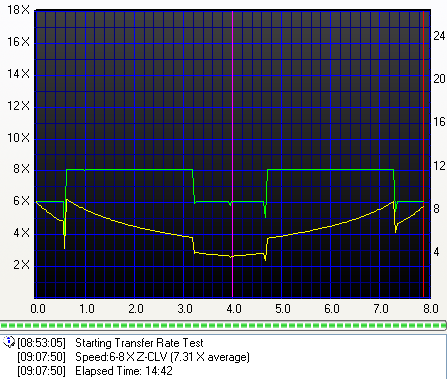
Some of the new DL media haven't been added to the firmware list yet and for this reason, the maximum writing speed is lower than certified. It is funny that the certified 2.4X media from Mitsubishi Chemicals can be burned at 8X, while media certified for 8X, only at 2.4X. The new DVD-R DL media from Traxdata also has to be added to the drive's firmware list for higher writing speeds other than 2X.
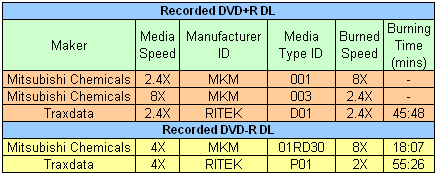
As we mentioned above, this time we decided to use the "Create Data Disc" feature of the CDSpeed utility. Because of this, there's no way to compare Pioneer's writing times with those of other drives.
13. DVD+R DL - Page 2
In order to test the Pioneer DVR-110's DL writing quality, we used the LiteOn SOHD-167T and the Plextor PX-716A drives, to scan the burned media.
- Traxdata +R DL media @ 2.4X


- Verbatim -R DL media @ 8X

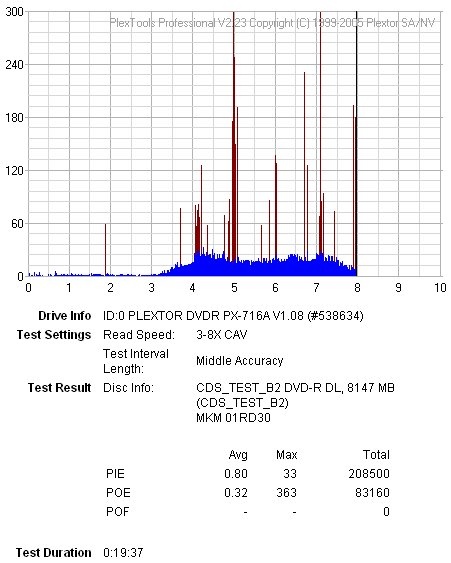
- Traxdata -R DL media @ 2X
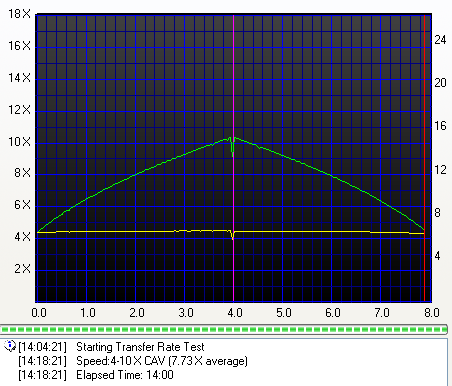

To be honest, we expected something better than the reported writing quality, although it is still good.
14. Conclusion

New readers are advised to read the original Pioneer DVR-110D review that contains the full reading tests.
The Pioneer DVR-110D returns with a better firmware. This newest firmware revision adds new media while improving the writing and reading performance of the drive. However, we feel there is still room for improvement. For example writing quality with RW media or with CMC Magnetics DVD-R 16X could be better.
At the time of this update, the price for the Pioneer DVR-110D on the e-market, Pricegrabber, newegg etc, is around US$45 for the bulk version. The rather low price, in combination with the great characteristics and performance, make the DVR-110D a very good purchase.